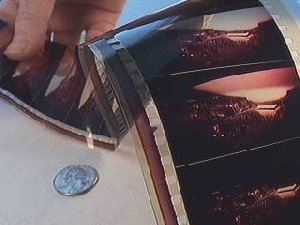| Release List | Reviews | Price Search | Shop | Newsletter | Forum | DVD Giveaways | Blu-Ray/ HD DVD | Advertise |
| Reviews & Columns |
|
Reviews DVD TV on DVD Blu-ray International DVDs Theatrical Reviews by Studio Video Games Features Collector Series DVDs Easter Egg Database Interviews DVD Talk TV DVD Talk Radio Feature Articles Columns Anime Talk DVD Savant HD Talk Horror DVDs Silent DVD
|
DVD Talk Forum |
|
|
| Resources |
|
DVD Price Search Customer Service #'s RCE Info Links |
|
Columns
|
 |
'65MM, 70MM, Whatever It Takes' I'm confused about the 70mm film format. On the laserdisc of WEST SIDE STORY, it is stated that there are now telecine machines transferring 70mm movies for the first time. How can this be, if they've been out on video many times before? Also, everyone keeps talking about 70mm prints and theaters. When I read about the filming of WEST SIDE STORY, or LAWRENCE OF ARABIA, all the articles talk about 65mm cameras, not 70mm. Which is it, and why the difference? This is a favorite topic. There have been so many largescreen film formats, with so many confusing names, that whole books have been written to straighten things out. As many of these formats were brief experiments, or were abandoned 30 years ago, not even Hollywood cameramen are familiar with all of them. It's we curious types who see a big logo for something like 'Super Technirama 70' splashed across the video screen and wonder just how super 'Super' was. If you haven't already been there, check out the Letterbox versus Pan 'n Scan page for some of the basic facts about film formats and their transfer to video. As for your question about 70mm transfers, and 65mm cameras: WEST SIDE STORY was shot in Super Panavision, on film 65mm wide. When WEST SIDE was exhibited in first-run roadshow theaters, the prints projected were 70mm wide. The reason they were 5mm wider was to accomodate magnetic soundtracks for multi-channel sound, which weren't needed in the camera. Some smart design engineer worked that into the system as an economy measure. So the negative film stock for 70mm is really 65mm wide. At Doug Trumbull's first 70mm effects facility, a dense film stock was needed to create optical matte composites, one not yet available in 65mm. An appropriate 70mm print stock existed, but it was too wide to fit into the 65mm optical printers! The solution was to custom-machine an edge-slicing jig, to trim off exactly 2.5 mm from each side of huge rolls of 70mm stock. Back to the telecine issue. Of course WEST SIDE STORY was released on home video before the 70mm film-to-video transfer machines were built. So have dozens of other 70mm films, such THE ALAMO or KHARTOUM. One must remember that, back when these films were new, 70mm prints were made only for roadshow engagements, in big cities. Even when WEST SIDE was brand new, as soon as it was out of the roadshow theaters, 35mm anamorphic reduction prints had to be made so it could be screened at the thousands of normal theaters that could not handle 70mm. When video came along, it was this reduction version that was transferred on a normal 35mm telecine machine. The primary reason to retransfer large-format films from their original 70mm printing negative is to gain the added picture quality. But even more interesting is the fact that the 70mm roadshow versions of many films were routinely longer than the subsequent 35mm releases. Intermission breaks were usually dropped, and the shows cut down to make them less lengthy to appease theater owners anxious to show the film more than twice in a day. On IT'S A MAD, MAD, MAD, MAD, WORLD, The roadshow release of the movie was substantially longer than the later 35mm version, so the new 70mm transfer represents the first opportunity in decades to see that film as it originally played. Another subtle benefit is to see more of the original image: when anamorphic reductions are made, a bit of picture can be lost from the top and bottom, because 35mm Cinemascope and Panavision are slightly wider formats than 70mm. In theory, in WEST SIDE STORY, there should be more footroom to see the dancers' feet!
Text © Copyright 1997 Glenn Erickson
Review Staff | About DVD Talk | Newsletter Subscribe | Join DVD Talk Forum |
|
| Release List | Reviews | Price Search | Shop | SUBSCRIBE | Forum | DVD Giveaways | Blu-Ray/ HD DVD | Advertise |





